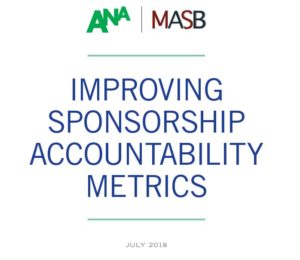Marketing expenditures on sponsorship have increased considerably over the past several years, but progress in measuring and assessing sponsorship’s business impact has been marginal, according to Improving Sponsorship Accountability Metrics, a new study conducted by the ANA (Association of National Advertisers) and MASB (Marketing Accountability Standards Board) to provide greater insight and guidance into sponsorship measurement.
 Total sponsorship spending in North America is estimated by ESP Properties (formerly IEG) to be $24.2 billion in 2018, up 41 percent since 2010, the year of the ANA’s first sponsorship measurement survey. The study revealed that only 37 percent of respondents reported having a standardized process for measuring Sponsorship ROI.
Total sponsorship spending in North America is estimated by ESP Properties (formerly IEG) to be $24.2 billion in 2018, up 41 percent since 2010, the year of the ANA’s first sponsorship measurement survey. The study revealed that only 37 percent of respondents reported having a standardized process for measuring Sponsorship ROI.
“Despite the continued growth of sponsorship investment and the repeated sentiment from marketers that there is a need for improved measurement and assessment, there has been little progress toward this goal,” said ANA CEO Bob Liodice. “It’s time for the industry to take a stand on sponsorship accountability, and this report is a first step in the right direction.”
The study also found that among those with a measurement process, 57 percent of respondents have a sponsorship measurement budget, and that among those, most spend only five percent or less on sponsorship measurement as a percentage of sponsorship rights (i.e., the cost of the sponsorship itself, not including activation costs).
ADDITIONAL FINDINGS
• Top metrics used to measure ROI (return on investment) of sponsorship are total sponsorship investment financial return, total media exposure financial return, and
product or service sales. These are also the top-valued ROI metrics. ROI metrics are focused on financial outcomes.
• Top metrics used to measure ROO (return on objective) of sponsorship are awareness of the brand, awareness of the company’s/brand’s sponsorship, attitudes towards the brand, amount of total media exposure, and amount of social media exposure. Top-valued metrics for ROO are awareness of brand, brand preference, and attitudes towards the brand. ROO metrics are focused on behavioral outcomes.
• The need for validated results for sponsorship initiatives has increased in importance for 78 percent of respondents, indicating that marketers are always under pressure to validate results.
• Only 40 percent of respondents write expectations about sponsorship measurement into contracts with properties, a finding that was interpreted as a missed opportunity.
“The survey points out the continuing, unmet need for more sophisticated sponsorship measurement and valuation practices,” said MASB President/CEO Tony Pace. “Developing and disseminating such practices is the next step for MASB’s Sponsorship Accountability Metrics Project team.”
CONCLUSIONS
The survey was the third of its kind (others were in 2010 and 2013). While it highlighted the ongoing need for advanced sponsorship measurement, it also confirmed only slight progress had been made toward reaching that goal because in all cases where comparisons were available, results did not change this year versus prior surveys.
The report also concluded that sponsorship accountability consists of three phases. The first is media equivalency, which measures the number of impressions generated and how much similar levels of impressions would cost. The second is return on objectives, and the third is financial attribution, which measures the financial outcomes generated from sponsorships and how they compare to other marketing investments. Sponsorship accountability should move towards the third phase of financial outcomes.
The report determined that brand preference should be a key sponsorship metric because it plays a pivotal role in financial outcomes and has the highest correlation to sales and share, even more than metrics such as awareness, brand loyalty, purchase intent, advocacy, and brand relevance. According to MASB, brand preference indicates the strength of a brand in the hearts and minds of consumers and represents which brands are preferred under assumptions of equality in price and availability.
The report recommends that marketers begin challenging the measurement community to assist with additional perspective and prioritize brand preference attribution for sponsorship, in addition to developing guidelines, benchmarks, and best practices.
